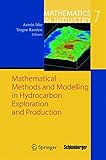Mathematical methods and modelling in hydrocarbon exploration and production
Material type: TextLanguage: English Publication details: Germany: Springer, 2005. Description: xii, 450p.; 21cmsISBN: 9783540225362Subject(s): Engineering mathematics -- Petroleum -- Prospecting | Engineering mathematics -- Computer science | Mathematical modelsDDC classification: 518 I75
TextLanguage: English Publication details: Germany: Springer, 2005. Description: xii, 450p.; 21cmsISBN: 9783540225362Subject(s): Engineering mathematics -- Petroleum -- Prospecting | Engineering mathematics -- Computer science | Mathematical modelsDDC classification: 518 I75
| Item type | Current library | Call number | Status | Date due | Barcode |
|---|---|---|---|---|---|
 Books
Books
|
Dr. S. R. Ranganathan Library General Stacks | 518 I 75 (Browse shelf(Opens below)) | Available | 2657 |
Browsing Dr. S. R. Ranganathan Library shelves, Shelving location: General Stacks Close shelf browser (Hides shelf browser)

|

|

|

|

|

|

|
||
| 515.7 L94:2 Optimization by vector space methods | 515.94 G87 Multivariable calculus | 518 C43, 3 Applied numerical methods with MATLAB for engineers and scientists | 518 I 75 Mathematical methods and modelling in hydrocarbon exploration and production | 518.1 B37 Design methods and analysis of algorithms | 518.1 D38 Algorithms | 518.285 C44, 4:1 Numerical mathematics and computing |
Hydrocarbon exploration and production incorporate great technology challenges for the oil and gas industry. In order to meet the world's future demand for oil and gas, further technological advance is needed, which in turn requires research across multiple disciplines, including mathematics, geophysics, geology, petroleum engineering, signal processing, and computer science.
This book addresses important aspects and fundamental concepts in hydrocarbon exploration and production. Moreover, new developments and recent advances in the relevant research areas are discussed, whereby special emphasis is placed on mathematical methods and modelling. The book reflects the multi-disciplinary character of the hydrocarbon production workflow, ranging from seismic data imaging, seismic analysis and interpretation and geological model building, to numerical reservoir simulation. Various challenges concerning the production workflow are discussed in detail.
The thirteen chapters of this joint work, authored by international experts from academic and industrial institutions, include survey papers of expository character as well as original research articles. Large parts of the material presented in this book were developed between November 2000 and April 2004 through the European research and training network NetAGES, "Network for Automated Geometry Extraction from Seismic". The new methods described here are currently being implemente
